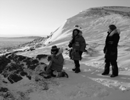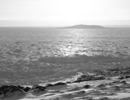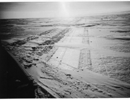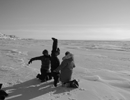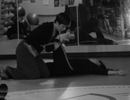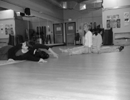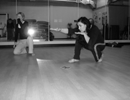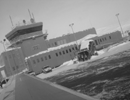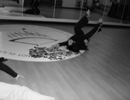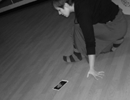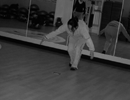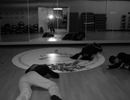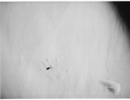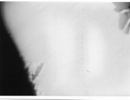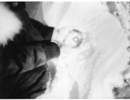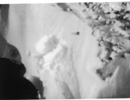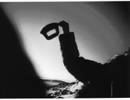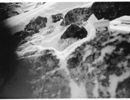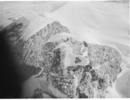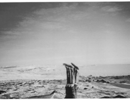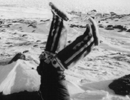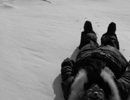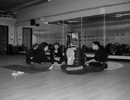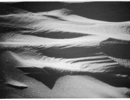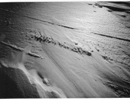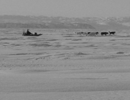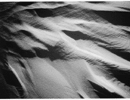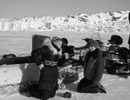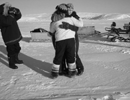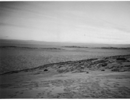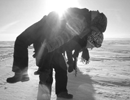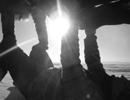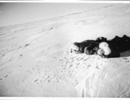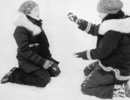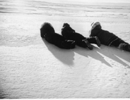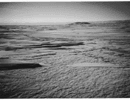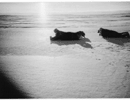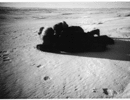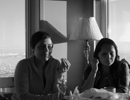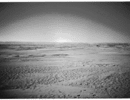

|< Back |
The Work: Iqaluit February 12-17, 2006
The Common Plants workshop undertaken February 12-17, 2006 in Iqaluit moved from an indoor studio space (Atii Fitness Centre) to outdoor locations including the snow-covered hills and shoreline in back of Kajjaarvik Bed & Breakfast where the creative/researchers stayed; Rotary Park on Iqaluit’s Road to Nowhere at the edge of town; two locations approximately ten kilometers out on the frozen ice in the vast, open “land”scape of Frobisher Bay, which were accessed via two snowmobiles pulling kamotiks (sleds made of wooden planks lashed together by cord).
February 13th
The creative/research team and the artists arrived at the Atii Fitness Centre, a square, one-storey building clad in royal blue corrugated metal, situated across the road from the canary yellow airport terminal building. Though Iqaluit’s airport has one of the longest runways in the world (the team missed seeing the new 550-passenger Airbus A380 aircraft by one day, in town for cold weather testing), the airport is at the edge of the town, easily within walking distance from art gallerys and other town amenities.
mThe creative/researchers (Judith Rudakoff, Nina Schriver, Belarie Zatzman, Laura Levin, Myles Warren) and the three artist participants (Jolene Arreak, Sylvia Cloutier, Celina Kalluk) began an intensive, four-day workshop. The immediate goals were to begin to work with the methodologies central to Common Plants, and to begin to evolve creative responses which will become part of the ongoing interactive, transcultural project.
mFor the first two days of the work, Dr. Levin observed and chronicled the details of the activites, and Dr. Zatzman observed and photographed archival footage for Dr. Schriver’s and her own analytical and theoretical work. Dr. Rudakoff and Dr. Schriver facilitated the creative workshops. Myles Warren, throughout the five days of work, observed and chronicled with a video camera.
In the studio, the morning was dedicated to Dr. Schriver’s body work and contact improvisation exercises. The afternoon began with each artist bringing forward and introducing the objects which Dr. Rudakoff had asked them, several weeks in advance of the workshop, to prepare. These were objects which should, the artists were tasked, represent “home” to them. Arreak brought three objects: a smooth, round, white stone which she picked up at her childhood home in Pond Inlet; her first ulu, or woman’s knife, with a handle now rusted with age; and an artistic reproduction on fabric of a letter she had written as a child to her grandmother (now returned to her by her ailing grandmother in anticipation of Arreak’s forthcoming first child in the spring). The letter was in Inuktitut and also in drawings depicting home, church, sun, flowers. Cloutier brought memories rather than objects: she remembered the details of her grandparents’ kitchen which included a yellow stove, a rocking chair, an onion. Kalluk brought images drawn by her three young children and a reproduction of one of her paintings of a woman transforming into a sea animal, part seal and part whale. The group discussed the creative implications and thematic links these images offered, and then the artists improvised physical and oral creative responses to these “seeds”.
mLater in the day, Dr. Rudakoff introduced her Lomogram image cards and the artists began to share more stories and images and subsequently to craft text and movement narratives inspired by the Lomograms, still within the themes of the project and through and including the stories and memories and objects already introduced by each artist, with Schriver and Rudakoff facilitating. The workshop employing physical, oral and written exercises continued to elicit and evolve creative responses from the three artists.
February 14th
February 14th continued work with the three artists and involved the further integration of Schriver’s physical work with Rudakoff’s creative process methodologies, introducing The Four Elements process into the work. After a session in the studio delivering the basic model of The Four Elements and a discussion of how this template might be applied and interpreted in personal life and as a creative resource and tool, the three artists, using The Four Elements, initiated and developed additional creative responses integrating physical vocabulary, throat singing, text fragments, non-verbal sounds, moving towards increasingly artistic evocations of the themes of the Common Plants project, continuing the focus on the theme of “home” and “land”.
February 15th
As the artists’ creative responses continued to develop, the work was relocated to an outside location on February 15th, onto the land. The first outdoor location was Rotary Park, at the edge of the town of Iqaluit, on a street called Road to Nowhere, accessible by four wheel drive vehicles. Dr. Rudakoff asked each artist to bring either their initial three objects, or a new object that evoked “home” for them in a distinct way. They were then asked to place the object(s) somewhere on the landscape and create a relationship between the object and its geographical context.
Cloutier chose her kamuks, her boots, which combined an outer layer handmade in Nunavut and an inner layer handmade in Nunavik, representing her dual heritage of Inuit culture and Quebecois culture. She stopped the vehicle en route to the Park, and on a roadside incline, she scrambled down to the level ground and staged a tableau of her lying on her back on the land, feet clad in her boots moving in the air, with clear, blue sky visible in half the image.
mArreak chose her ulu and had it lomographed with the sky in the background; a can of “Klik” processed meat lomographed on a snow-covered rock; her handmade mittens lomographed on a rock holding the ulu. Kalluk first chose her ring, made of black whale tooth, and had it lomographed on her hand, pressed into the snow. She then had the ring lomographed a second time, placed on the snowprint of her hand, on her ring finger. Other images she chose to have lomographed included different placements of the same ring. (Informally, Kalluk also used her body as a representation of home in relation to landscape, choosing to lie prone on the ground, gazing up at the sky. Kalluk re-created this still image, photographed rather than lomographed, in several geographical locations and this impromptu tableau proved to be an extremely evocative image of life, death, home, self, connections. She accompanied this pose with the text fragment “If you lie on your back, you’re blinded by blue.”)
The day ended with a discussion indoors of the work thus far and the participants as well as Rudakoff and Schriver continued to share and explore images of home and the importance of expressing landscape through physicalization, vocalization and storytelling.
mLevin and Zatzman spent time at Inuksuk High School, engaging with students, exploring the possibilities of applying the project’s transcultural methods and univeral themes. Zatzman initiated an integration of the Common Plants methodology with her own similarly configured explorations of home and self in relation to the arts, and Levin was able to observe and chronicle the work for further analysis in the pedagogical model being developed through the project.
February 16th
This was planned as a day out on the ice, weather permitting, in an open location on the ice of Frobisher Bay, near Tar Inlet. The southerners (Rudakoff, Schriver and Warren) borrowed parkas and snowpants to layer on top of “southern winter apparel”, and food and hot drinks were arranged. The appointed place to meet mid-morning was a coffee shop at the water’s edge, to allow for easier access for the snowmobiles and kamotiks. After a few delays, the team headed out at a brisk 40 kilometers an hour and, lashed by wind and under the powerful light of the Arctic sun, shortly arrived at the first destination.
Despite temperatures that hovered at minus thirty five celcius, Schriver lead physical exercises for the artists and the entire group recognized the studio process work as it began to transform into creative response. The addition of bulky clothing and the interaction of the artists with the landscape transformed what had started as graceful, artistic movement in the mirrored studio at the fitness centre into angular, driven, sculptural fragments. Rudakoff referenced the Element work and the text and story fragments which the artists had generated and then continuing working with and then, together, Schriver and Rudakoff suggested to the artists that they focus on creating sculptures rather than sequences. This opened new possibilities better suited to the immediate environment.
At the urging of our guide Claude Roussel, the group moved from this very flat, open area to a second location, about ten minutes further out on the ice. A site was chosen next to a large ice formation created by the shifting of the tides under the frozen ice. As food and drink were unpacked, a loud, series of cracking sounds reverberated in the vast quiet of the landscape: this was the effect of the tide rising and the ice shifting. This was another reminder that the team was not standing on land, per se, but rather on water, separated by ice approximately six feet deep.
After the meal break, the ensuing work referenced all the movement, voice, text and story work developed in the studio, but this time in direct relation to the dramatic context of the landscape as home. The creative response work that emerged spoke to and from individual experience, through personal filters, incorporated learned and tacit knowledge, integrated new skills within areas of expertise and was, as a result, universal in both affect and accessibility.
After approximately four hours on the ice Rudakoff and Schriver asked the Arreak, Cloutier and Kalluk for a creative response that they would like us to show the other participants in Common Plants elsewhere in the world, especially those in South Africa about to begin the same process work with Lomograms and The Four Elements, as well as Schriver’s body work and contact improvisation exercises. As throughout the project, and with the permission of the artists, we photographed, lomographed and videoed the work from the perspective of archival documentation. The artists offered three improvised creative responses. The first was a narrative, text (English and Inuktitut) and movement based enactment of a woman’s realization that her strength, her roots come from the water, and that she is inextricably connected to the land.
The second creative response was non-narrative and took for form of the three women chanting and moving in unision, linked together as if one body, employing throat-singing techniques in ways not usually used (that is, three women back to back rather than two women face to face) to express a connection with the landscape. The words chanted and sung in Inuktitut were “Sun, Warm, Cold”. The effect of spiralling and rooting down into the land, the ice, the water was complemented by the sense of a circuit of energy being created, with the link to the sky, the sun and the air.
The third creative response, less developed but nonetheless evocative, involved the three women beginning by lying on the snow-covered ice and telling a story of the relationship between seals and their hunters.
mAs the afternoon light was starting to fade and Roussel was anxious to return to land, the group packed the gear into the kamotiks, and headed back to land for a final session indoors.
The culmination of this portion of the Common Plants workshop in Iqaluit took place at the Kajjaarvik Bed & Breakfast, where Rudakoff, Schriver, Arreak and Kalluk discussed the work accomplished. The artists were invited, in particular, to offer feedback on what they had discovered from both the artistic and the personal perspective. Ongoing feedback continues through a combination of electronic media (from telephone to blogging to email), and it is anticipated that the next stage of creative response development will take place in the Spring.
These photographs and lomographs were taken by various members of the group.
|< Back |
Please note that these lomographic images are copyright material. Use or transfer without my express permission is an infringement of this copyright.
|
|
![]()

